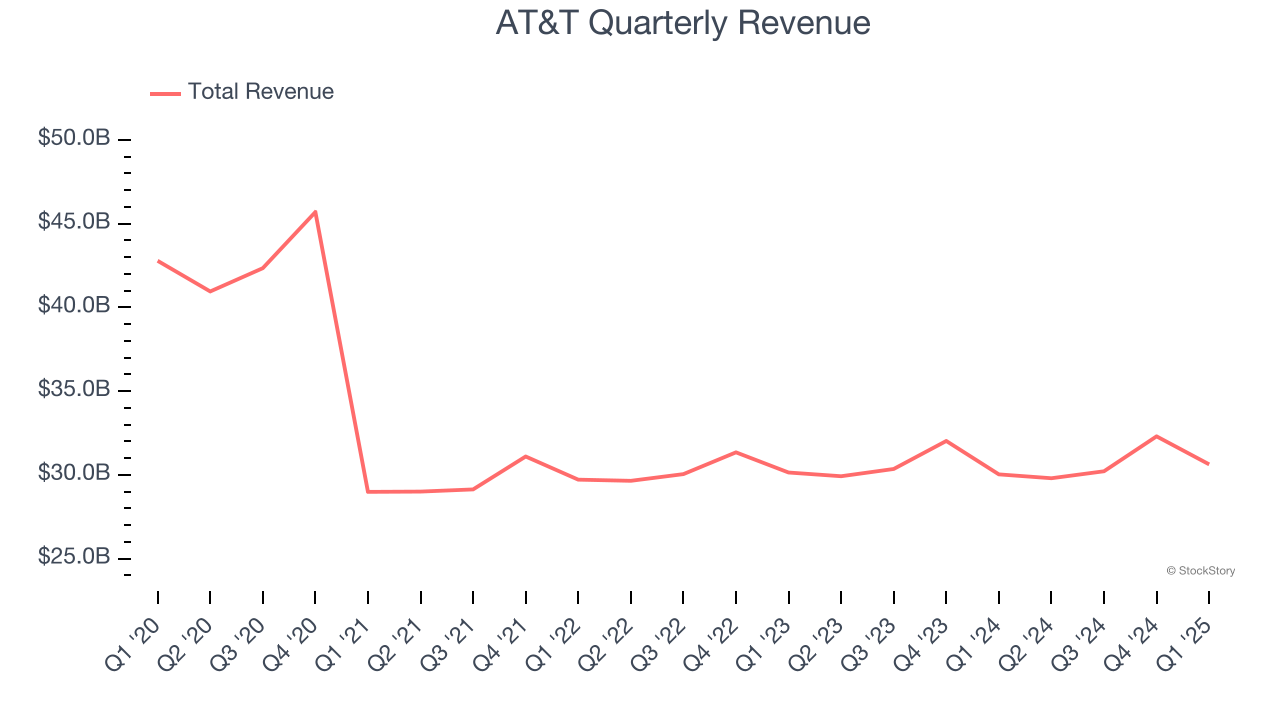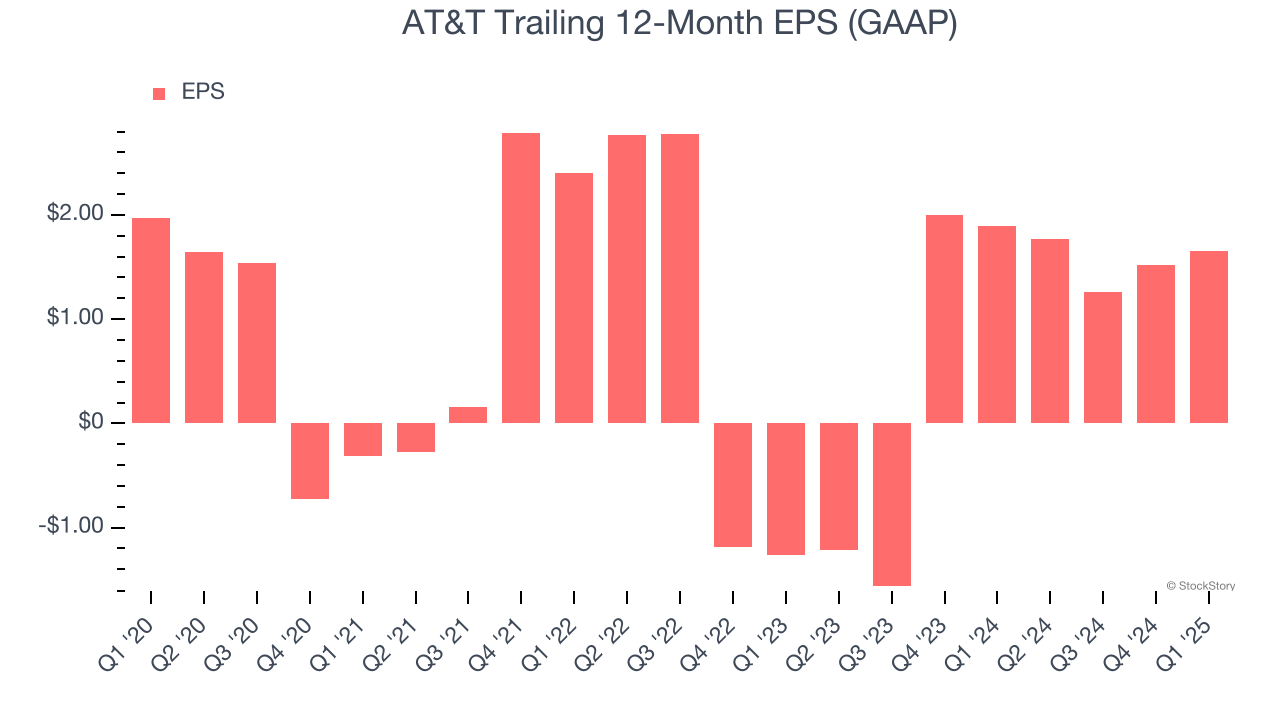
Telecommunications conglomerate AT&T (NYSE: T) reported Q1 CY2025 results topping the market’s revenue expectations, with sales up 2% year on year to $30.63 billion. Its GAAP profit of $0.61 per share was 23.4% above analysts’ consensus estimates.
Is now the time to buy AT&T? Find out by accessing our full research report, it’s free.
AT&T (T) Q1 CY2025 Highlights:
- Revenue: $30.63 billion vs analyst estimates of $30.34 billion (2% year-on-year growth, 1% beat)
- EPS (GAAP): $0.61 vs analyst estimates of $0.49 (23.4% beat)
- Adjusted EBITDA: $10.94 billion vs analyst estimates of $11.32 billion (35.7% margin, 3.3% miss)
- Operating Margin: 18.8%, in line with the same quarter last year
- Free Cash Flow Margin: 15.6%, up from 10.5% in the same quarter last year
- Market Capitalization: $193.5 billion
Company Overview
Founded by Alexander Graham Bell, AT&T (NYSE: T) is a multinational telecomm conglomerate providing a range of communications and internet services.
Wireless, Cable and Satellite
The massive physical footprints of cell phone towers, fiber in the ground, or satellites in space make it challenging for companies in this industry to adjust to shifting consumer habits. Over the last decade-plus, consumers have ‘cut the cord’ to their landlines and traditional cable subscriptions in favor of wireless communications and streaming video. These trends do mean that more households need cell phone plans and high-speed internet. Companies that successfully serve customers can enjoy high retention rates and pricing power since the options for mobile and internet connectivity in any geography are usually limited.
Sales Growth
Examining a company’s long-term performance can provide clues about its quality. Even a bad business can shine for one or two quarters, but a top-tier one grows for years. AT&T’s demand was weak over the last five years as its sales fell at a 7.3% annual rate. This wasn’t a great result and is a sign of lacking business quality.

Long-term growth is the most important, but within consumer discretionary, product cycles are short and revenue can be hit-driven due to rapidly changing trends and consumer preferences. AT&T’s revenue over the last two years was flat, sugggesting its demand was weak but stabilized after its initial drop in sales. 
AT&T also breaks out the revenue for its most important segment, Mobility. Over the last two years, AT&T’s Mobility revenue (wireless plans) averaged 2.3% year-on-year growth. This segment has outperformed its total sales during the same period, lifting the company’s performance.
This quarter, AT&T reported modest year-on-year revenue growth of 2% but beat Wall Street’s estimates by 1%.
Looking ahead, sell-side analysts expect revenue to grow 1.1% over the next 12 months, similar to its two-year rate. This projection is underwhelming and implies its newer products and services will not accelerate its top-line performance yet.
Today’s young investors won’t have read the timeless lessons in Gorilla Game: Picking Winners In High Technology because it was written more than 20 years ago when Microsoft and Apple were first establishing their supremacy. But if we apply the same principles, then enterprise software stocks leveraging their own generative AI capabilities may well be the Gorillas of the future. So, in that spirit, we are excited to present our Special Free Report on a profitable, fast-growing enterprise software stock that is already riding the automation wave and looking to catch the generative AI next.
Operating Margin
AT&T’s operating margin has been trending down over the last 12 months, but it still averaged 17.2% over the last two years, top-notch for a consumer discretionary business. This shows it’s an efficient company that manages its expenses effectively.

In Q1, AT&T generated an operating profit margin of 18.8%, in line with the same quarter last year. This indicates the company’s overall cost structure has been relatively stable.
Earnings Per Share
Revenue trends explain a company’s historical growth, but the long-term change in earnings per share (EPS) points to the profitability of that growth – for example, a company could inflate its sales through excessive spending on advertising and promotions.
Sadly for AT&T, its EPS and revenue declined by 3.5% and 7.3% annually over the last five years. We tend to steer our readers away from companies with falling revenue and EPS, where diminishing earnings could imply changing secular trends and preferences. Consumer Discretionary companies are particularly exposed to this, and if the tide turns unexpectedly, AT&T’s low margin of safety could leave its stock price susceptible to large downswings.

In Q1, AT&T reported EPS at $0.61, up from $0.48 in the same quarter last year. This print easily cleared analysts’ estimates, and shareholders should be content with the results. Over the next 12 months, Wall Street expects AT&T’s full-year EPS of $1.65 to grow 26.3%.
Key Takeaways from AT&T’s Q1 Results
We enjoyed seeing AT&T beat analysts’ revenue and EPS expectations this quarter. Overall, this quarter had some key positives. The stock traded up 3.4% to $27.88 immediately following the results.
AT&T may have had a good quarter, but does that mean you should invest right now? If you’re making that decision, you should consider the bigger picture of valuation, business qualities, as well as the latest earnings. We cover that in our actionable full research report which you can read here, it’s free.
